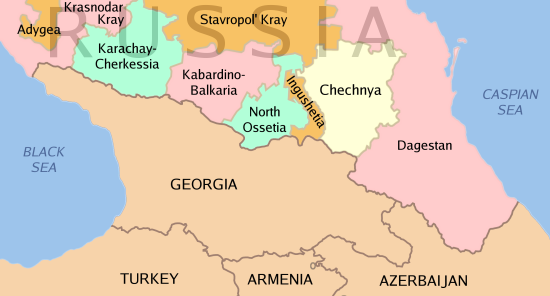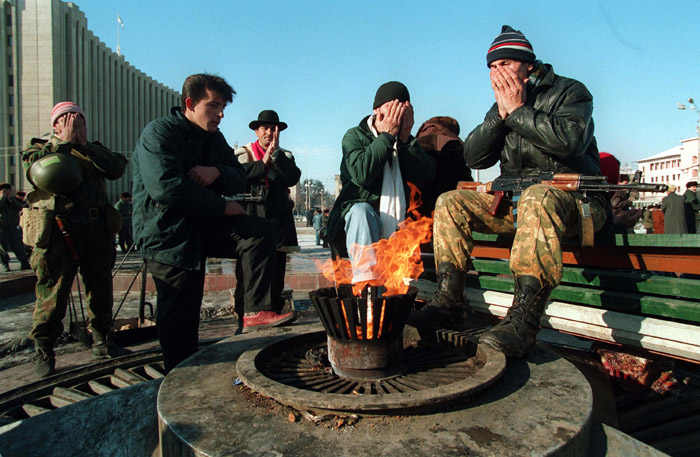|
Chechen Republic Of Ichkeria
The Chechen Republic of Ichkeria ( ; ce, Нохчийн Республик Ичкери, Nóxçiyn Respublik Içkeri; russian: Чеченская Республика Ичкерия, Chechenskaya Respublika Ichkeriya; abbreviated as "CHRI" or "CRI"), known simply as Ichkeria, and also known as Chechnya, is a former '' de facto'' state that controlled most of the former Checheno-Ingush ASSR. The First Chechen War of 1994–1996 resulted in the victory of the separatist forces. After achieving ''de facto'' independence from Russia in 1996, kidnappings and violence between gangs plagued the region, which the government was unable to control. In November 1997, Chechnya was proclaimed an Islamic republic. The Second Chechen War began in August 1999, with Ichkeria falling and subsequently being forcibly subsumed back under the control of the Russian central government in 2000. An insurgency followed soon thereafter, officially ending in April 2009 after several years of conflict. S ... [...More Info...] [...Related Items...] OR: [Wikipedia] [Google] [Baidu] |
Autonomous Soviet Socialist Republics
An Autonomous Soviet Socialist Republic (ASSR, russian: автономная советская социалистическая республика, АССР) was a type of Subdivisions of the Soviet Union, administrative unit in the Soviet Union (USSR) created for certain Demographics of the Soviet Union#Ethnic groups, nations. The ASSRs had a status lower than the constituent republics of the Soviet Union, union republics of the USSR, but higher than the Autonomous oblasts of the Soviet Union, autonomous oblasts and the autonomous okrugs of the Soviet Union, autonomous okrugs. In the Russian Soviet Federative Socialist Republic, Russian SFSR, for example, Chairmen of the Government of the ASSRs were officially members of the Council of Ministers of the Russian SFSR, Government of the RSFSR. Unlike the union republics, the autonomous republics only had the right to disaffiliate themselves from the Union when the union republic containing them did so, as well as to choose to stay ... [...More Info...] [...Related Items...] OR: [Wikipedia] [Google] [Baidu] |
Dokka Umarov
Doku Khamatovich Umarov ( ce, Ӏумар Хьамади кӀант Докка, translit='Umar Ẋamadi khant Dokka, ; russian: Доку Хаматович Умаров, Doku Khamatovich Umarov; 13 April 1964 – 7 September 2013), also known as Dokka Umarov as well as by his Arabized name of Dokka Abu Umar, was a Chechens, Chechen mujahid in North Caucasus. Umarov was a major military figure in both wars in Chechnya during the 1990s and 2000s, before becoming the leader of the greater insurgency in the North Caucasus. He was active mostly in south-western Chechnya, near and across the borders with Ingushetia and Georgia (country), Georgia. During the late 1990s, after Chechnya's first war against Russia, Movladi Udugov's status as war hero enabled him to take the post of the breakaway Republic's Security Minister. Between 2006 and 2007, following the death of his predecessor Abdul-Halim Sadulayev, Sheikh Abdul Halim, Umarov became the underground President of Ichkeria of the unr ... [...More Info...] [...Related Items...] OR: [Wikipedia] [Google] [Baidu] |
Chechen Naxar
The naxar ( ce, нахар, co-spelled ''nakhar'' or ''nahar'') is the currency that Chechen separatists planned for the Chechen Republic of Ichkeria. In 1994, in the UK, banknotes were printed in denominations of 1, 3, 5, 10, 20, 50, 100, 500, and 1000 nahar, dated 1995. Colnect.com. Retrieved 2022-12-08. This currency was not put into circulation, and almost all printed banknotes stored in bank of were destroyed by the |
Russian Ruble
''hum''; cv, тенкĕ ''tenke''; kv, шайт ''shayt''; Lak: къуруш ''k'urush''; Mari: теҥге ''tenge''; os, сом ''som''; tt-Cyrl, сум ''sum''; udm, манет ''manet''; sah, солкуобай ''solkuobay'' , name_abbr = руб, Rbl , image_1 = Banknote_5000_rubles_2010_front.jpg , image_title_1 = banknote of the current series , image_2 = Rouble coins.png , image_title_2 = Coins , iso_code = RUB , date_of_introduction = 14 July 1992:RUR (1 SUR = 1 RUR)1 January 1998:RUB (1,000 RUR = 1 RUB) , replaced_currency = Soviet ruble (SUR) , using_countries = , unofficial_users = , inflation_rate = 12.0% (November 2022) , inflation_source_date Bank of Russia, inflation_method = CPI , unit = ruble , subunit_ratio_1 = , subunit_name_1 = kopeyka (копейка) ''tiyen''; ba, тин ''tin''; cv, пус ''pus''; os, капекк ''kapekk''; udm, коны ''kony''; Mari: ыр ''yr''; sah, харчы ''harchy'' , symbo ... [...More Info...] [...Related Items...] OR: [Wikipedia] [Google] [Baidu] |
Caucasus Emirate
The Caucasus Emirate ( ce, Имарат Кавказ, Imarat Kavkaz, IK; russian: Кавказский эмират, Kavkazskiy emirat), also known as the Caucasian Emirate, Emirate of Caucasus, or Islamic Emirate of the Caucasus, was a Jihadist organisation active in rebel-held parts of Syria and previously in the North Caucasus region of Russia. Its intention was to expel the Russian presence from the North Caucasus and to establish an independent Islamic emirate in the region. The ''Caucasus Emirate'' also referred to the state that the group sought to establish. The creation of Caucasus Emirate was announced on 7 October 2007, by Chechen warlord Dokka Umarov, who became its first self-declared "emir"."Two years of Imarat Kavkaz: jihad spreads over Russia's south" , ''Caucasian Kn ... [...More Info...] [...Related Items...] OR: [Wikipedia] [Google] [Baidu] |
Battle Of Grozny (1999–2000)
The 1999–2000 battle of Grozny was the siege and assault of the Chechen capital Grozny by Russian forces, lasting from late 1999 to early 2000. The siege and fighting left the capital devastated. In 2003, the United Nations called Grozny the most destroyed city on Earth. Between 5,000 and 8,000 civilians were killed during the siege, making it the bloodiest episode of the Second Chechen War. Prelude On 15 October 1999, after mounting an intense tank and artillery barrage against Chechen separatists, Russian forces took control of a strategic ridge within artillery range of Grozny. They then made several abortive attempts to seize positions on the outskirts of the city. On 4 December, the commander of Russian forces in the North Caucasus, General Viktor Kazantsev, claimed that Grozny was fully blockaded by Russian troops. General Anatoly Kvashnin, chief of the army's general staff, even predicted the rebels would abandon the Chechen capital on their own, urged to withdraw by ... [...More Info...] [...Related Items...] OR: [Wikipedia] [Google] [Baidu] |
Second Chechen War
The Second Chechen War (russian: Втора́я чече́нская война́, ) took place in Chechnya and the border regions of the North Caucasus between the Russia, Russian Federation and the Chechen Republic of Ichkeria, from August 1999 to April 2009. In August 1999, Islamist fighters from Chechnya War of Dagestan, infiltrated Russia's Dagestan region, violating Russia's borders. During the initial campaign, Russians, Russian military and pro-Russian Chechens, Chechen paramilitary forces faced Chechen separatists in open combat and seized the Chechen capital Grozny after a winter Battle of Grozny (1999–2000), siege that lasted from December 1999 until February 2000. Russia established direct rule over Chechnya in May 2000 although Chechen militant Resistance movement, resistance throughout the North Caucasus region continued to inflict heavy Russian casualties and challenge Russian political control over Chechnya for several years. Both sides carried out attacks a ... [...More Info...] [...Related Items...] OR: [Wikipedia] [Google] [Baidu] |
First Chechen War
The First Chechen War, also known as the First Chechen Campaign,, [Armed conflict in the Chechen Republic and on bordering territories of the Russian Federation] Федеральный закон № 5-ФЗ от 12 января 1995 (в редакции от 27 ноября 2002) "О ветеранах" or the First Russian-Chechen war, was a war of independence which the Chechen Republic of Ichkeria waged against the Russia, Russian Federation from December 1994 to August 1996. The first war was preceded by the Russian Intervention in Ichkeria, in which Russia tried to covertly overthrow the Ichkerian government. After the initial campaign of 1994–1995, culminating in the devastating Battle of Grozny (1994–1995), Battle of Grozny, Russian federal forces attempted to seize control of the mountainous area of Chechnya, but they faced heavy resistance from Chechen guerrilla warfare, guerrillas and raids on the flatlands. Despite Russia's overwhelming advantages in firepower, manp ... [...More Info...] [...Related Items...] OR: [Wikipedia] [Google] [Baidu] |
Declaration Of Sovereignty Of The Chechen Republic
On November 1, 1991, Head of the All-National Congress of the Chechen People, Dzokhar Dudayev issued a Decree of Sovereignty of the Chechen Republic (russian: УКАЗ ПРЕЗИДЕНТА ЧЕЧЕНСКОЙ РЕСПУБЛИКИ o гоСУДАРСТВЕННОМ СУВЕРЕНИТЕТЕ ЧЕЧЕНСКОЙ РЕСПУБЛИКИ). Between 1991 and 2000 Chechnya was de facto an independent state. Background Government building storming On 7 September 1991, the NCChP National Guard seized government buildings and the radio and television center of the Checheno-Ingush ASSR, an autonomous Soviet republic. The storming caused the death of the Soviet Communist Party chief for Grozny, Vitali Kutsenko, who was either thrown out of a window or fell trying to escape during a supreme soviet session, and effectively dissolved the government of the Chechen-Ingush ASSR. Referendum Prior to the inauguration of the decree was an independence referendum held on October 27, 1991, with a large majori ... [...More Info...] [...Related Items...] OR: [Wikipedia] [Google] [Baidu] |
Government-in-exile
A government in exile (abbreviated as GiE) is a political group that claims to be a country or semi-sovereign state's legitimate government, but is unable to exercise legal power and instead resides in a foreign country. Governments in exile usually plan to one day return to their native country and regain formal power. A government in exile differs from a rump state in the sense that a rump state controls at least part of its former territory. For example, during World War I, nearly all of Belgium was occupied by Germany, but Belgium and its allies held on to a small slice in the country's west. A government in exile, in contrast, has lost all its territory. However, in practice the difference might be minor; in the above example, the Belgian government at Sainte-Adresse was located in French territory and acted as a government in exile for most practical purposes. The governments in exile tend to occur during wartime occupation or in the aftermath of a civil war, revolution, ... [...More Info...] [...Related Items...] OR: [Wikipedia] [Google] [Baidu] |
Dissolution Of The USSR
The dissolution of the Soviet Union, also negatively connoted as rus, Разва́л Сове́тского Сою́за, r=Razvál Sovétskogo Soyúza, ''Ruining of the Soviet Union''. was the process of internal disintegration within the Soviet Union (USSR) which resulted in the end of the country's and its federal government's existence as a sovereign state, thereby resulting in its constituent republics gaining full sovereignty on 26 December 1991. It brought an end to General Secretary Mikhail Gorbachev's (later also President) effort to reform the Soviet political and economic system in an attempt to stop a period of political stalemate and economic backslide. The Soviet Union had experienced internal stagnation and ethnic separatism. Although highly centralized until its final years, the country was made up of fifteen top-level republics that served as homelands for different ethnicities. By late 1991, amid a catastrophic political crisis, with several republics alread ... [...More Info...] [...Related Items...] OR: [Wikipedia] [Google] [Baidu] |



.jpg)